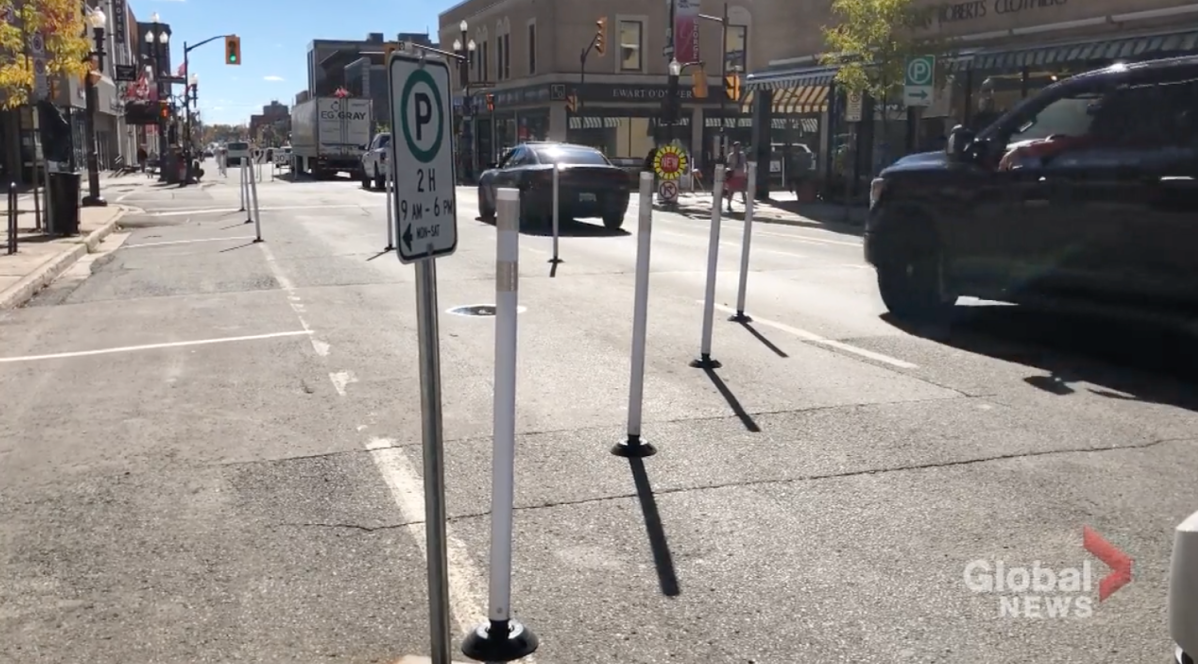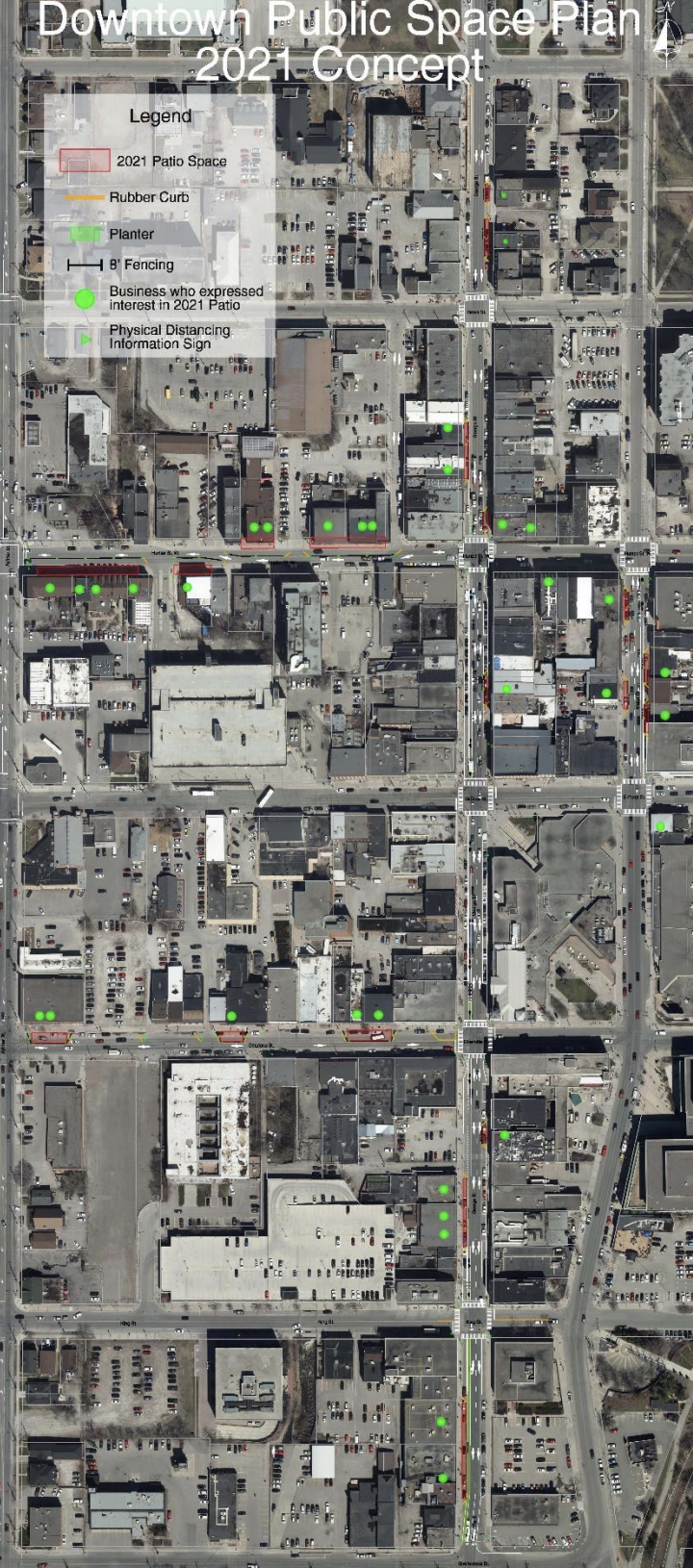Further changes to downtown Peterborough streets and sidewalks in 2021 — including no use of bollards — are being proposed starting this spring amid the COVID-19 pandemic.

A city working group’s extensive report going to city council for approval on Monday offers a number of modifications to the layout of downtown’s streets and sidewalks and also reviews the extensive changes implemented during 2020 to assist businesses and pedestrians while following provincial COVID-19 protocols and health measures — including bollards to increase sidewalk space, temporary one-way streets and removal of some on-street parking.
The measures — in consultation with Peterborough Public Health and the Peterborough Downtown Business Improvement Area — took effect in June and most remained in place until October.
The report also provides feedback from businesses and a public survey of nearly 1,500 respondents on last year’s changes in the downtown.
The working group says in 2021 there will be improved use of sidewalk space and a more “tailored approach” to space design and different delineators.
The changes and plans proposed include:
- Jasper mayor says CN Rail relocation will be devastating: ‘Deeply disappointed’
- Retired Quebec teacher buys winning lottery ticket at last minute, wins $40M
- N.B. election: Higgs went to ‘very dark place’ with Liberal joke, opponent says
- GM, Volvo, Land Rover vehicles among those in big recall. What to know
George and Water street sidewalks:
- Proposes George and Water Street be maintained with two lanes of traffic this year for vehicles and cyclists.
- Requests for expanded patio space will be accommodated by converting existing parking spaces to patio areas, only in areas requested by businesses, meaning it’s a customized layout. There will still be on-street parking.
Hunter Street:
- Maintain much of the same configuration as 2020 to allow for expanded patios to use the available sidewalk space.
- Traffic will be shifted in a similar manner as in 2020, with one-way traffic maintained in the westbound direction.
- Use a combination of portable planters, delineators and/or temporary fencing treatments to provide physical separation and enhance accessibility for those with low vision.
“Given the current configuration of the sidewalks on Hunter Street, they have already been designed to accommodate seasonal patios on a permanent basis,” states Cynthia Fletcher, the city’s commissioner of infrastructure and planning services.
“With the existing space available, it would be difficult to maintain adequate sidewalk width to allow for physical distancing when these existing approved patios are in operation. Creating a temporary sidewalk space within the closed traffic lane along Hunter Street will provide opportunities to maintain public safety on this corridor.
“Based on feedback received from the public survey, it is proposed to upgrade the treatment used to separate the temporary pedestrian space from traffic.”
Charlotte Street:

Get daily National news
- Similar to 2020, planned as a one-way street, eastbound, between Aylmer Street and George Street to allow for adequate public space for physical distancing between competing priorities.
- Patios for restaurants will be able to expand into the current parking lanes and a portion of the former westbound travel lane, while pedestrian traffic will remain on the current sidewalks to improve accessibility.
Other changes:
Space delineators:
- Proposing to replace bollards the use of portable planters along with decorative fencing to de-mark the space in the parking lanes to be used for expanded patios and displays.
“The bollards came up as a common theme during the review and consultation on the changes that were implemented last year,” stated Brendan Wedley, the city’s manager of communications on behalf of Fletcher. “Concerns with the bollards included the aesthetics — their looks — as well as accessibility with comments about needing stronger visual cues to separate the areas and the feeling of safety. To respond to the feedback, the recommendation includes using different treatments for delineating between traffic lanes and pedestrian spaces, such as fencing and portable flower planter boxes.”
Patios/tables/displays:
- Due to updated requirements for licensed facilities, proposal to leave the sidewalks for pedestrian/accessible modes of travel and set up patios/tables/displays in the parking lanes.
“This setup creates more consistency for pedestrians/accessible modes and still allows for potential expansion of other priorities into the on-street parking spaces.”
Parking spaces/roadway/sidewalk:
- The modifications to the parking lanes will be focused in front of businesses that seek a permit to use the space for expanded patio/display space.
“Rather than a ‘one-size fits all approach’, members of the working team will assist with a more customized design of the space,” the report states.
Parking fees:
- Proposed on-street pick-up zones will be continued, along with regular enforcement of the two-hour parking limit and the continuation of charging for on-street parking in the downtown. In 2020, parking fees were waived between April and August.
“Feedback on the look and function of the bollard was fairly negative,” the report states. “The planters and fencing treatments will look more pleasing, be quite heavy when filled and de-mark the space well. While more costly than the delineators, new patio enclosures can be reused for future patio applications beyond the COVID period, and the city may be able to recover a portion of the costs through future patio permit fees or the sale of the equipment to business owners for their annual patio.”
In a statement to Global News Peterborough, Terry Guiel, the DBIA’s executive director says the 2021 proposal is a “vast improvement” over last year’s.
“Its functionality is much more balanced between restaurant and retail this year,” he said. “I also like that they will be increasing parking and pick up zones. Kudos to the city for adopting many of the recommendations from various surveys of businesses and the community as well as taking into account the guidance from our own DBIA Mobycon Report we commissioned to study last year’s changes and its recommendations for changes. There are still many competing interests at play and not all will be happy, but it’s a decent compromise.
Public survey
Activities that brought people into the downtown:
- 70 per cent of respondents indicated they travelled through downtown to get to their destination.
- 58 per cent of respondents indicated they picked up food for takeout.
- 56 per cent of respondents indicated they went into a store for shopping.
- 53 per cent of respondents indicated they used a patio for dining.
- 44 per cent of respondents indicated they used curbside pickup for shopping/retail.
- 32 per cent of respondents indicated they went into a restaurant for dining.
The report also recommends a level of “delegated authority” to allow for required modifications to be implemented in a timely manner to meet the needs of downtown businesses — such as adding or moving parking spaces, pickup space or adjusting time limits to parking spaces.
“In 2020, there were approximately 12 adjustments made to the original layout,” Fletcher notes.
The report estimates the temporary changes will cost the city $135,000, which can be covered under $1.1 million the city received through the 2021 COVID-19 recovery funding program.















Comments